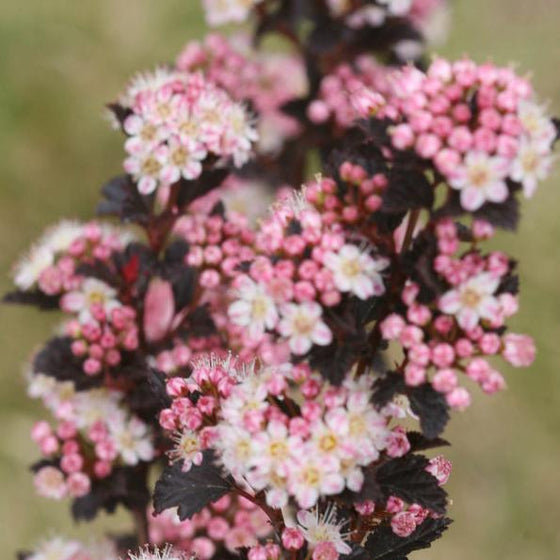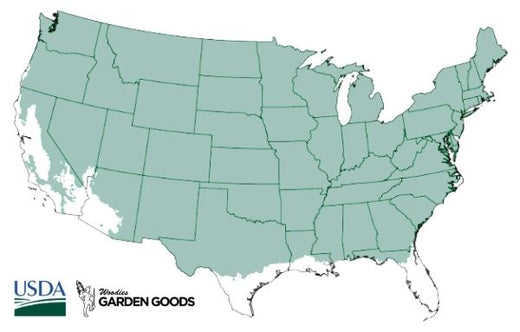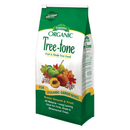Physocarpus such as Physocarpus Tiny Wine grow best if they are fertilized once in the spring and once in the summer. Although some authorities recommend special fertilizer mixes to get the maximum results, Ninebarks do amazingly well with a more relaxed approach. Apply an early spring fertilizer with a product such as Espoma Tree-tone or Plant-tone at the recommended rate this will give the plant a boost of nitrogen that will be needed for healthy abundant foliage. Follow this up with a early summer application of Espoma Flower-tone, this will provide the necessary nutrients and raise the acid level in the soil which mahonia favor. Espoma products are easy to use, just sprinkle around the base of the plant and water it in. Be careful with products such as miracle-grow as these products can burn newly planted plants when not used at the recommended rates. Slow-release fertilizer can help prevent rapid sucker growth that is vulnerable to diseases and insects. Either chemical fertilizers or organic matter can be used successfully. Since an organic method of applying manure and/or compost around the roots, produces excellent results and also improves the condition of the soil, this would be an excellent first line of attack. Organic additions to the soil can also be combined with a shot of chemical fertilizer for maximum effect. If chemical fertilizers are used on your Physocarpus Tiny Wine, applying a slow-release, balanced fertilizer once a year is probably the simplest solution. There are many slow-release fertilizers on the market. If you can find a fertilizer formulated for shrubs and trees, this fertilizer would work well on Physocarpus. However, slow-release is certainly not the only way to fertilize ninebarks. A less expensive fast release fertilizer such as a 10-10-10 will work just as well if applied twice during the summer. If you are looking for a fertilizing routine tailored to your specific conditions, a soil sample should be taken and the fertilizer and trace elements matched to the needs of your soil. Don't fertilize Physocarpus Tiny Wine after August. Fall is the time for Physocarpus to begin preparing for dormancy. Fertilizing at this time may stimulate new growth that will be too tender to withstand the winter. In the South, a late May application and another in July would be about right. More northern areas may wish to fertilize only once in June or July. The amount of chemical fertilizer used per plant will vary with the size of the plant and it's root system. Over-fertilization can be much more detrimental than under-fertilization. "Fertilizer burn" can occur when too much fertilizer is applied, resulting in a drying out of the roots and damage or even death of the Physocarpus.It is much, much better to err on the side of too little fertilizer than too much. When roots are burned, the first sign is often scorched looking leaves. If over-fertilization is severe, the plant may just wilt and die. If you are a beginner at growing plants Physocarpus Tiny Wine is very easy to grow however it may be helpful to know that a very small plant which is planted in the ground will take about 1/8 - 1/4 cup of fertilizer. When fertilizing Physocarpus in pots, be careful to apply a fertilizer that will not burn the roots (such as a slow release or a liquid fertilizer). A very large shrub in the ground will take 2 - 3 cups spread around the drip line of the branches (not next to the trunk). This is a very loose estimate, so please read the directions on the fertilizer before applying it. If a liquid fertilizer is used for Physocarpus Tiny Wine, it should be applied every month for both plants in pots and in the ground. Never fertilize a plant with a chemical fertilizer if the plant looks sick or wilted. If a plant is struggling due to a disease or root problems, the fertilizer will only add stress to it's life. Try to cure the problem before adding fertilizer. For an organic approach, many gardeners use commercial manure on the soil around ninebarks such as Physocarpus Tiny Wine. Excellent results have been reported by visitors to this site after using composted manure. Commercial manure or compost can be applied yearly around the base of the Physocarpus Tiny Wine. As with chemical fertilizers, do not apply it right next to the trunk or stems emerging from the ground.program. When looking at most fertilizers, they are described by three numbers on the bag. An example would be 10-10-10 or 12-4-8. The first of these three numbers refers to Nitrogen, which is the primary element necessary for good, balanced growth within the plant. Plants that are deficient in Nitrogen are usually not growing vigorously, and sometimes exhibit pale colored foliage. Not all Nitrogen deficiencies result in stunted growth. Sometimes, the growth is taller and longer with less than desirable branching when Nitrogen is deficient. The second number in the fertilizer equation is representative of Phosphorus. A deficiency of Phosphorus may affect the energy transfer in the plant, and result in stunted growth as well. Also, plants with insufficient amounts of Phosphorus may have poorer root systems. Potassium is the element represented by the third number on the fertilizer bag. Plants that are deficient in Potassium, are usually growing more slowly than normal, have fewer flowers and seed, and are more susceptible to disease than plants with adequate levels of Potassium. Although the three elements just mentioned are the major elements necessary for good plant performance, there some minor elements that are just as important in consideration of plant nutrition. Minor elements that are not included in the three numbers listing on the front of fertilizer bags are very important considerations when choosing your plant fertilizer. Elements such as Magnesium, Sulfur, Calcium, Iron, Manganese, Copper, Zinc, Boron, and Molybdenum play very important roles in providing Physocarpus with adequate nutrition. Many times, less expensive fertilizers are sold that contain only the major elements needed, but not the minor elements. Always be sure to look on the fertilizer label on the back of the bag to see exactly what is included in the fertilizer. In choosing the basic type of fertilizer to suit your Physocarpus Tiny Wine, it is important to determine what you need your Physocarpus to do. If your Physocarpus Tiny Wine plants are well established, and you are not concerned about more growth, choose a fertilizer that has a smaller first number, and a larger second and third number. When you have selected your fertilizer and are ready to apply it, be sure to rake your mulch back to the drip line of each plant. Apply the fertilizer according to the label directions immediately on top of the soil, and be sure to water the plant thoroughly after the application. You can then rake the mulch back around the base of the Physocarpus. Although it is tempting to spend less time by not raking the mulch back during fertilization, the results will be less than desirable, if the fertilizer is applied on top of the mulch. Proper fertilization of your Physocarpus Tiny Wine will lead to healthier and more disease resistant plants, as well as provide you with many more enjoyable blooms. Always, read the label on your fertilizer bag, and follow the instructions.















